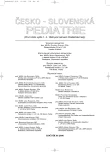Late Diagnostics and Therapy of Pyloric Membrane
Authors:
M. Vyhnánek; J. Šnajdauf; O. Petrů; M. Rygl; J. Nevoral 1
Authors‘ workplace:
Klinika dětské chirurgie 2. LF UK a FN Motol, subkatedra dětské chirurgie IPVZ, Praha
přednosta prof. MUDr. J. Šnajdauf, DrSc.
; Pediatrická klinika 2. LF UK a FN Motol, Praha
přednosta prof. MUDr. J. Vavřinec, DrSc.
1
Published in:
Čes-slov Pediat 2006; 61 (7-8): 424-427.
Category:
Case Report
Overview
The authors present the case history of a two-year boy who has been repeatedly examined and treated outside Czech Republic for lacking thriving and for vomiting. The boy was examined since his birth and treated conservatively for gastroesophegeous reflux. Based on the 24h examination of pH-metry of esophagus and endoscopy of esophagus at another workplace the boy was indicated to antireflux plasty. Before the operation other examinations at our workplace included X-ray contrast examination of esophagus, stomach and gastroscopy with the conclusion of incomplete obstruction of pylorus. In the subsequent surgical revision a pyloric membrane was found of 3 mm thickness and the opening could not be identified. The membrane was partially excised and pyloroplasty was performed according to Mikulizcz. Since 8th day after the operation the patient was given food, which was tolerated well. He is still without complaints one year after the operation.
Key words:
pyloric membrane, diagnostics, therapy
Labels
Neonatology Paediatrics General practitioner for children and adolescentsArticle was published in
Czech-Slovak Pediatrics

2006 Issue 7-8
Most read in this issue
- Alobar Holoprosencephaly – A Case Report of Two Cases
- Indication and Principles of Molecular-Genetic Investigation
- The Therapy of the Deep Cartilage Defects in the Knee Joint by the Transplantation of Cultivated Autologous Chondrocytes in Children and Adolescents
- Cardiopulmonary Resuscitation – Novel Recommended Procedures
